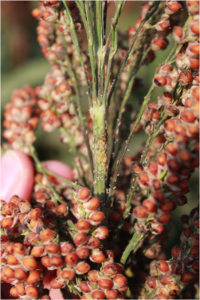Ronnie Schnell, Assistant Professor and State Cropping Systems Specialist, College Station
Statewide:
Sugarcane aphids were a major pest in grain sorghum during 2014, affecting most production regions of Texas. While direct yield loss was not an issue for many growers, excessive honey production resulted in reduced harvest efficiency for some growers. Aphids located in the upper canopy and grain heads before harvest are a concern (Figure 1). As growers look for options to manage sugarcane aphids, planting hybrids with genetic resistance to the sugarcane aphid will be a major component of an integrated pest management program.
As information on resistant grain sorghum hybrids becomes available, it is important to understand the terminology related to resistance and what results growers should expect from hybrids with various forms of resistance. Resistant hybrids have genetic traits that result in one or more of the following:
· Less damage than a plant without the resistant trait
· Yields more than a susceptible hybrid when confronted with pest invasion
· Suppressed insect pest abundance
· Elevated tolerance level
There are three kinds of resistance that will alter the relationship between insect pests and the host plant. This includes antibiosis, antixenosis and tolerance. Antibiosis is a type of resistance where the host plant causes injury, death, reduced longevity or reduced reproduction of the pest. Antibiosis will reduces pest numbers and damage to the plant. This is what many associate with true resistance. Antixenosis, also known as non-preference, is when the pest does not desire this plant due to color, odor, texture, etc. Tolerance is the final form of resistance where the plant is able to withstand or recover (repair) from damage caused by the pest. A tolerant plant will remain healthy and yield well despite presence of pest. Although, there may not be a reduction in pest (aphid) numbers or honeydew production.
The main difference between resistance (as antibiosis or antixenosis) and tolerance is that resistance causes an insect response and tolerance results in a plant response. A hybrid that reduces aphid numbers and damage to the plant under field conditions, especially when the pest is present during critical growth periods, is resistant. As seen in Figure 2, the resistant breeding line on the left shows little evidence of aphid damage compared to the susceptible breeding line on the right that failed to produce a head. Tolerance to late season aphid infestations may show reduced plant damage and reduced honeydew levels but should not be interpreted as resistance. Furthermore, whether planting resistant or tolerant grain sorghum hybrids, growers should scout fields as usual to monitor occurrence and changes in aphid populations.

Figure 2. A grain sorghum breeding line that is resistant (left) to sugarcane aphids and a breeding line that is susceptible to sugarcane aphids (right). From Dr. Bill Rooney, taken at Weslaco, TX in October 2013.
For further Texas A&M AgriLife discussion of a practical view toward current grain sorghum hybrids that the grain sorghum industry has designated as ‘Tolerant’ see the Jan. 29 “Sorghum Tip” published by Texas Grain Sorghum Association at http://texassorghum.org/sorghum-tips.
